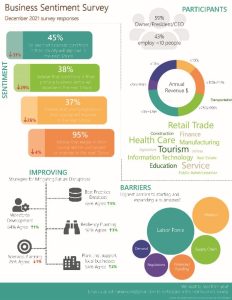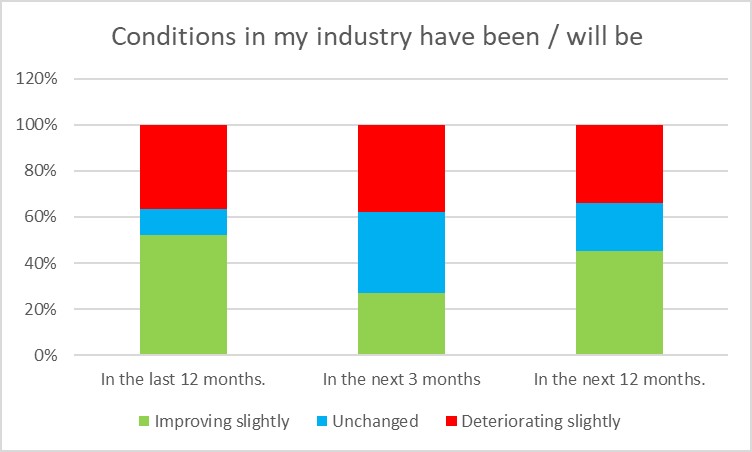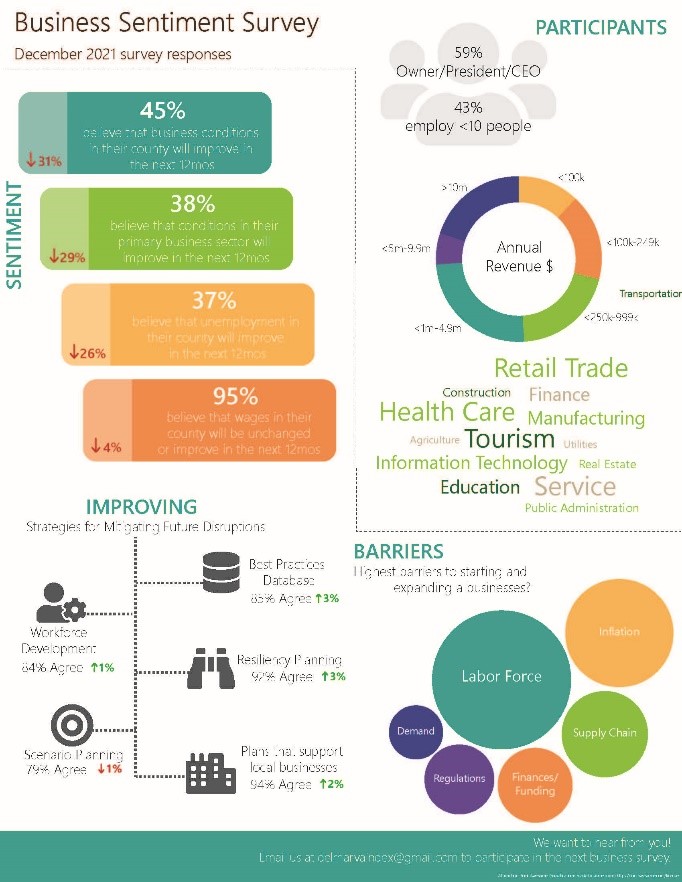
SALISBURY, MD – Eastern Shore business owners and managers are optimistic about the economic outlook over the next 12 months, though their enthusiasm has waned over the past six months.
These trends are among the findings of the Eastern Shore Business Sentiment Survey conducted through a partnership with Salisbury University’s Business Economic and Community Outreach Network (BEACON), SU’s Eastern Shore Regional GIS Cooperative (ESRGC), and many of the region’s economic and workforce development professionals.
“A business sentiment survey is an effective way to gauge the health of the Eastern Shore economy,” said John Hickman, BEACON director. “When business leaders are optimistic, the economy is likely performing well. If survey respondents are more pessimistic in their views, storm clouds could be gathering on the economic horizon.”
BEACON and its partners released the first survey in June 2021 and conducted a follow-up in December 2021.
“Repeating the same questions over time is important because the results will show the changing business climate and the most pressing issues,” said Hickman. “The respondents switched their second- and third-place concerns, with inflation overtaking supply chain concerns, a reversal from the June 2021 survey. This reflects the increase in inflation over the past few months and shows that businesses are learning to operate in the supply constrained environment.”
The survey included more than 50 questions, asking business leaders to weigh in on a range of topics, from general business concerns to conditions in their own industries. Respondents evaluated business conditions locally, regionally, in the state and nationwide for the coming year. They also shared views related to their specific industries and on issues from labor supply to regulations.
Results include:
- Respondents in December were optimistic about business conditions over the next 12 months, with 45% predicting better or much better conditions locally and on the Eastern Shore, and 42% expecting better conditions in Maryland and nationally. Only 19% predicted worse or much worse conditions locally, though 29% saw conditions worsening statewide and nationally.
- Reflecting on their individual industry sectors, respondents shared that conditions improved in the past 12 months. However, they were cautious about conditions in the next three-month period, with increasing optimism for the next 12-month period.
- Respondents indicated that COVID-19 had caused new problems for businesses and has exacerbated existing problems, particularly related to workforce, a response that reflects national trends.
- Concerns about inflation have grown in the past six months, overtaking supply chain issues. Labor force issues remain atop the list of barriers to both starting and expanding a business.
Businesses remain supportive of the range of tools that economic development offices have deployed, ranging from long-term economic resiliency plans to workforce development programs, with 85-95% of respondents supporting the continuation of the programs after COVID-19.
The June survey included businesses in Caroline, Dorchester and Talbot counties, while the December survey was distributed to a wider audience that included Somerset, Wicomico and Worcester counties. Expanding the recipient pool allowed researchers to gain an understanding of the concerns of the region as a whole.
“The most interesting outcome of the December survey is how quickly things change in business,” said Debbie Bowden, Caroline County economic development director. “The responses confirm what I am hearing about the impact of inflationary pressures on current and future business conditions. This just shows that we have to be agile with our support for our county businesses.”
“This survey is just one tool that we use to monitor the local economy, but it is a very powerful tool indeed,” said Cassandra Vanhooser, Talbot County economic development and tourism director. “Having business owners and managers take the time to give us insight into what they are thinking give us very valuable information. It helps us understand how national trends are playing out on the local level.”
The ESRGC summarized the findings in an infographic that can be found on the Eastern Shore Economic Recovery Project website, but economic developers also have access to an internal dashboard that enables them to mine the data for insight on specific issues.
“The infographic is a perfect way to boil down this collective feedback and communicate the big picture to a wide audience,” said Erin Silva, ESRGC project manager. “The dashboard, however, gives the economic development directors and partners the ability to explore the data at a much finer scale. For example, they can visualize responses just for their county and for a specific sector, as well as track this information over time.”
Counties on the Eastern Shore will continue to conduct the survey every six months, with the data used to identify challenges facing the region, to assist in long-term planning and to guide the development of public policy.
“Collecting honest feedback and opinions not only allows for real-time insight into the health of our businesses, but it also assists us in making data-driven decisions,” said Susan Banks, Dorchester County economic development director. “Now that we have completed two surveys, we can compare data and watch for current and future trends. The trends will drive our response to business needs.”
Designed to gauge the opinions of the region’s business leaders, this survey is one of the tools that has grown out of the Eastern Shore Economic Recovery Project, a venture made possible by grants totaling $507,000 from the U.S. Economic Development Agency (EDA). The Mid-Shore Regional Council and the Tri-County Council of the Lower Eastern Shore are recognized as Economic Development Districts by the EDA.
In addition to the two regional councils, partners in the project include ESRGC, BEACON, the Lower Shore Workforce Alliance, the Upper Shore Workforce Investment Board, and the Caroline, Dorchester, and Talbot County economic development offices.
To access Eastern Shore Economic Recovery Project data, visit https://recovery.delmarvaindex.org. The complete Delmarva Index can be found at https://delmarvaindex.org.
For more information visit the BEACON website at www.salisbury.edu/beacon and the ESRGC website at www.esrgc.org.







